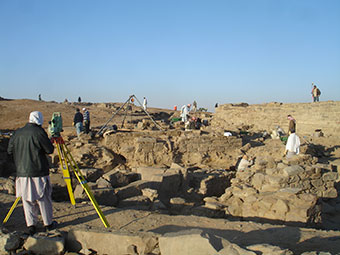Crossroads of Culture: The Archaeology of Saudi Arabia
Freer Gallery of Art,
Meyer Auditorium
Saturday, November 17, 2012
Speakers and Program
9:30–10am Coffee
Freer Conference Room
10am–12pm Opening Remarks
Julian Raby, The Dame Jillian Sackler Director of the Arthur M. Sackler Gallery and the Freer Gallery of Art
Who Were the Prehistoric People of Arabia?
James L. Phillips, Field Museum of Natural History, Chicago
Along with Eastern Africa, the Southern Levant contains the earliest evidence of modern humans and direct evidence of changes in settlement, technological, and symbolic systems. Two routes led our ancestors into the Levant and southwestern Asia. One went through the Bab-el-Mandab into the Saudi Peninsula; the second, with modern humans moved through Egypt, went into the Sinai and the Dead Sea Rift. This presentation offers evidence of an in situ development of modern human behavior, represented by the transition from the Middle to the Upper Paleolithic, and the initial direct evidence of the development of a distinct Upper Paleolithic industry, the earliest in the world, dating to circa 48,000 calibrated years BP.
Tayma in the Context of Interregional Networks
Ricardo Eichmann, German Archaeological Institute, Berlin
According to recent archaeological excavations, the ancient oasis of Tayma (northwest Saudi Arabia) was at latest populated in the late third millennium BCE and fenced by an 11-mile-long wall. The site had been frequented by pastoralists and caravans because of its rich water resources. The Tayma region played an important role in interregional networks and attracted the attention of the former superpowers of the second and first millenniums BCE (Levant, Egypt, and Babylonia). Tayma had at least a 1,500-year-long tradition when Nabonidus (556–539 BCE) choose it as his residence for ten years. Later, the oasis was dominated by Lihyanite and Nabataean kings (fourth century BCE–first century CE), as is attested by inscriptions found in the deposits of a large public building that may have served initially as a temple, in use at least until the fourth century CE or later.
The Hegra Archaeological Park Project
Laila Nehme, French National Center for Scientific Research, Paris
Madâin Sâlih, ancient Hegra, is a site of extraordinary beauty and historical interest. It was the southernmost city of the Nabataeans, a people of Arab origin who, thanks to their involvement in the long-distance trade, controlled the routes, levied taxes, and became very rich. Their kingdom stretched from Damascus in the north to the Hijâz in the south, and the main cities they built were Bosra in southern Syria, Petra in Jordan, and Hegra in Saudi Arabia. The lecturer, a specialist in Nabataean archaeology and epigraphy, undertook excavations in these three cities. Since she has been directing the Hegra Archaeological Project for the last ten years, the focus of this talk will be on this wonder of the North Arabian Desert, which is much less well known to the general public than its famous counterpart in Jordan. Rock-cut architecture is omnipresent in both sites and it is not a mere coincidence that Petra means “stone” in Greek and Hegra means “stone” in Arabic.
Hellenistic “Theory” and South Arabian Reality: Foundation Myths of Thaj, the Largest Site in Eastern Arabia
Daniel Potts, Department of Archaeology, University of Sydney
Thaj has attracted attention since the early twentieth century, when Capt. W.H.I. Shakespear first documented several funerary inscriptions in Old South Arabian script found at the site. The use of a script imported from Yemen, which boasted the greatest concentration of fortified towns and cities in pre-Islamic Arabia, naturally raises intriguing questions about the origins of Thaj, its people, and its formidable city wall. Yet literary and numismatic evidence also attests to Greek influence in eastern Arabia in the aftermath of Alexander the Great’s conquests. This talk will examine the archaeological evidence from Thaj in an attempt to better understand the course of sociopolitical development in this region during the later pre-Islamic era. Who were the people of Thaj? What was their relationship to the Sabaean civilization of South Arabia? Where was the ancient site of Gerrha? What became of Thaj when the Arsacids (Parthians) came to power in Mesopotamia?
Saudi Arabia Meeting Place of Civilizations
Ali al-Ghabban, Vice President of Antiquities and Museums at the Saudi Commission for Tourism and Antiquities
12–1 pm Lunch on your own
Traditional Middle Eastern cuisine is available for purchase in the Ripley Center Concourse
1–2 pm Roundtable Discussion
“Balancing Past, Present, and Future Archaeological Projects in Saudi Arabia”
Participants: Ali Al Ghabban (vice president of antiquities and museums at the Saudi Commission for Tourism and Antiquities), Ricardo Eichmann, Laila Nehme, James L. Phillips, Daniel Potts.
Discussion Leader: Alexander Nagel, assistant curator of ancient Near East, Freer|Sackler

Archaeological Excavations at Tayma in northwestern Saudi Arabia. DAI Orient-Abteilung, A. Hausleiter